Ivo Blom wrote ‘All the Same or Strategies of Difference: Early Italian Comedy in International Perspective’, an article about the silent Italian comedy, published in Italian Silent Cinema. A Reader. You can now read Ivo's interesting article at his website. What were the characterisations of and differences between the typical comedians of the early Italian cinema like Cretinetti, Polidor, Kri-Kri and Robinet? And which were the differences between slapstick and situational comedy such as the Morano-Rodolfi comedies by Ambrosio? Ivo also compares the Italian silent comedies with its French and American counterparts at Pathé, Gaumont and Vitagraph. The online publication of the article matches EYE’s wonderful recent upload of several Italian silent comedies from the Desmet Collection at YouTube. For EFSP, Ivo made this selection from our collections with vintage postcards of Italian silent comedians and comedies.
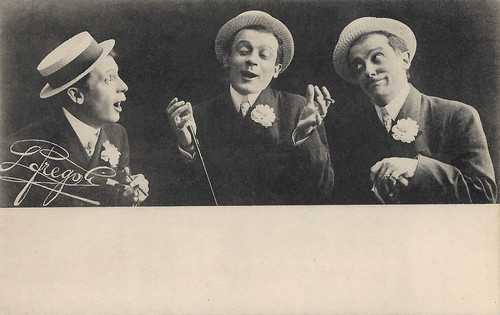
Italian postcard by Garzini e Pezzini, Milano, 1908.
Leopoldo Fregoli (1867-1936) was one of the first vaudeville actors who used film in his acts. Fregoli was famous for his rapid transformation acts, in which he did impersonations of famous artistic and political characters. In 1898 he bought a Cinematographe from the Lumière brothers and started to show shorts, named Fregoligraph, as part of his stage act. These were recordings of his transformation acts.
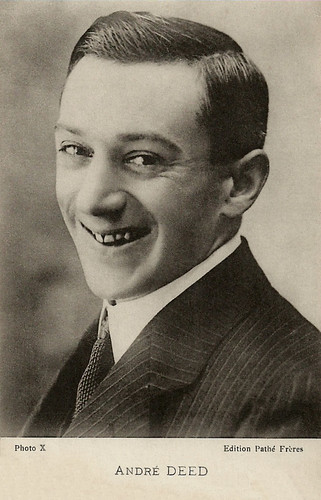
French postcard by Edition Pathé Frères. Photo: X.
One the most popular comedians in the French and the Italian silent cinema was André Deed (1879-1940) who was known under the names of Boireau and Cretinetti. In 1908, the Torinese company Itala lured him from Pathé to Italy, where Deed started the series of Cretinetti (‘little stupid’). He not only acted, but also directed his films. Deed behaved in a quite anarchic way, creating destruction and pursuits allover. Between 1909 and 1911 and between 1915 and 1920 Deed made 90 shorts with Cretinetti, such as the absurdist Cretinetti e le donne (1910), in which fanatic women tear the man to pieces. In the end all his loose limbs gather again.
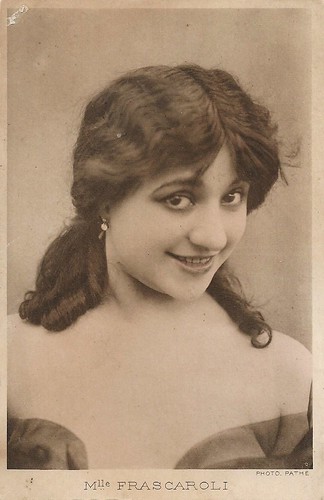
French postcard. Photo: Pathé. Caption: M[ademoise]lle Frascaroli.
Valentina Frascaroli (1890-1955) was an Italian actress of the silent screen. After a training in dance and acting, she performed on stage. In 1909 she was hired by Itala Film, first as a screenwriter, then as actress. At Itala, she became the beloved companion of former Pathé comedian André Deed, known in Italy as Cretinetti and in France as Gribouille. She followed him to France when he returned to Pathé, now as Boireau. Frascaroli also had her own comedies there as the character Griboulette. Between 1915 and 1922 she acted in many, mostly dramatic Italian films such as Maciste alpino (1916), Tigre reale (1916), La guerra e il sogno di Momi (1917), etc. - mostly at Itala Film. Already in the early 1910s, she had acted opposite Ermete Zacconi in Padre (1912) and would be paired with him again in L'emigrante (1915). Frascaroli retired from the screen in 1925 but continued to perform on stage.
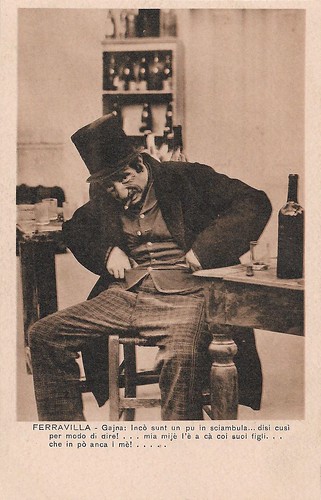
Italian postcard by IPA CT Duplex, no. 5899. Photo Comerio, Milano. V. Uff. Rev. St. Terni. Edoardo Ferravilla in Tecoppa & c.. Caption (in Milanese dialect): Gajna: I am a bit in shambles, so to say! My wife is at home with her children, which are a bit also mine! Ferravilla here performs his character Tecoppa.
Edoardo Ferravilla (1846-1915) was an actor and playwright of the Italian stage and silent screen. He performed in Milanese dialect and became the darling of the Italian public. Between 1913 and 1915, Ferravilla also had a short but successful film career. He thus immortalised some of his most popular sketches, and linked the early cinema to the repertoire of an ancient stage tradition.
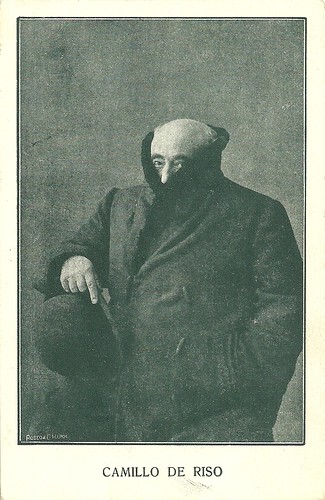
Italian postcard by Magazine Film - corriere dei cinematografici, Napoli / Roma. Photo Roseo & Co, Naples / Caesar Film.
Italian screen and stage actor and director Camillo De Riso (1854-1924) was most famous for his comedies at the companies Ambrosio, Gloria and Caesar. In 1912 he was hired by Ambrosio Film in Turin, where he formed a successful trio with Gigetta Morano and Eleuterio Rodolfi, contributing with his rotund face, small size and generous look of bourgeois bonhomme. Examples are Un successo diplomatico and L’oca alla Colbert, both 1913 and both directed by Rodolfi. The films of the trio were often based on Italian and French fin de siecle pochades and grew in length over the years. In late 1913, De Riso started at the Gloria company. Here he created the gay epicure and shameless libertine character of ‘Camillo’, and directed himself in a series of comical shorts between 1913 and 1914.
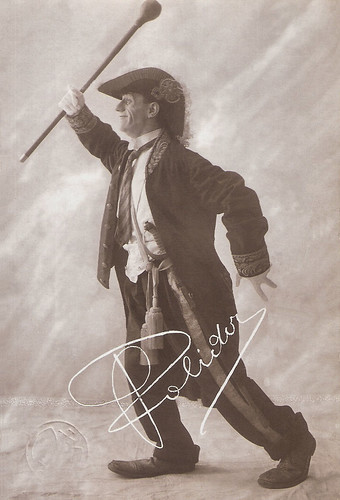
Italian postcard by Tip. Sent by mail in 1922.
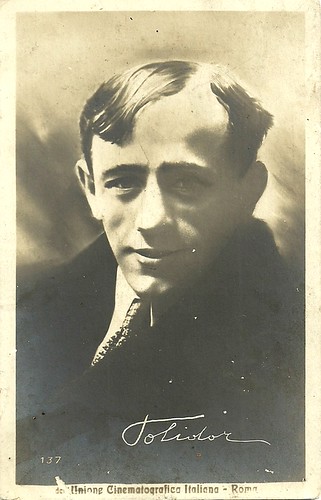
Italian postcard by La Rotofotografica / Unione Cinematografica Italiana, no. 137.
Italian comical actor Ferdinand Guillaume (1887-1977) was famous in the 1910s as Tontolini and as Polidor. He was enrolled by the Cines company in 1910 together with his brother Natale and their wives. Guillaume was launched as the character Tontolini, in 1912 also known in Britain and the US as Jenkins. Guillaume provided Cines and Italy an international reputation in the field of comedies. Actress Lea Giunchi, who was married to Natale (Natalino) Guillaume, often played as 'Lea' in the Tontolini comedies. Later she became the regular film partner of Kri-Kri (Raymond Frau), who more or less substituted Guillaume when the latter moved over to Pasquali. After some 100 shorts as Tontolini, and after the success of his first feature-length film, Pinocchio (Giulio Antamoro, 1911), Ferdinand Guillaume went over to the Pasquali company. Here he created the character of Polidor named after a horse in his old circus shows. From 1912 till 1914, he shot some 100 Polidor films, which were distributed all over Europe and the US.

Italian postcard by Fotocelere.
Italian actress Luigia 'Gigetta' Morano (1887–1986) was very popular as a comedian in the early 1910s at the Ambrosio film studio. She had her own comic series with the type Gigetta. Together with Eleuterio Rodolfi, her partner on screen and her most prolific director, she did countless comedies, both shorts and longer films. At Ambrosio, she also acted in dramatic parts, e.g. as Lucia in I promessi sposi (Eleuterio Rodolfi, 1913).
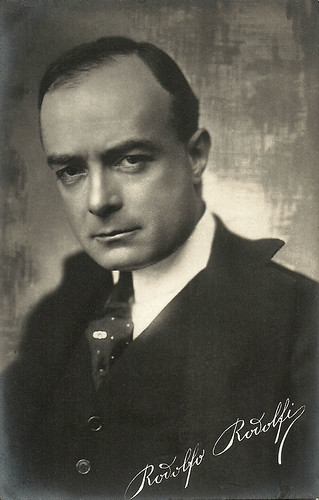
Italian postcard by Fotocelere.
Eleuterio Rodolfi (1876-1933) was an Italian actor, director and scriptwriter, who was highly active in the Italian silent cinema. For Ambrosio, Rodolfi acted in some 95 films of which some 80 ones were directed and scripted by himself. Many of these were comedies in which Rodolfi and Gigetta Morano played ‘Gigetta’ and ‘Rodolfi’. In contrast to the previous ‘comiche’ the anarchist farces by Cretinetti and others focused on speed and havoc, the comedies with Gigetta and Rodolfi were true ‘commedie’, so more situational, boulevardier, less speedy, and often hinting at forbidden fruits and voyeurism.
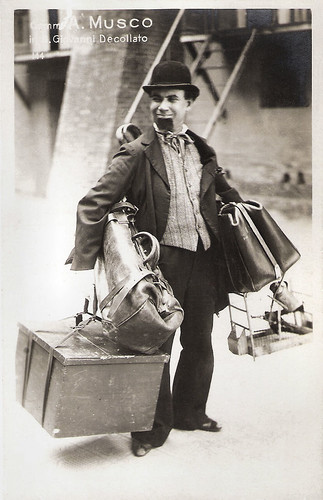
Italian postcard by Ed. Vettori, Bolgna. Angelo Musco in San Giovanni Decollato (Telemaco Ruggeri, 1917).
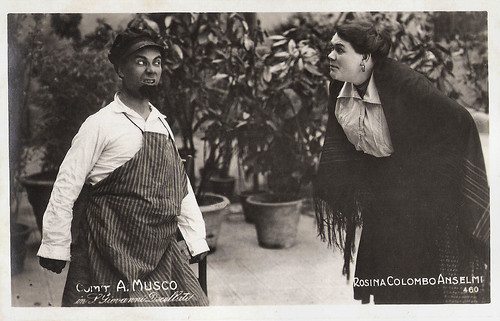
Italian postcard. This could be a postcard for either the film San Giovanni Decollato (Telemaco Ruggeri, 1917) or the play by Nino Martoglio on which it was based and which he had written for Musco. Angelo Musco (1872-1937) played in both film and stageplay. The woman on this card could be Rosina Anselmi, playing Musco's wife. All the actors in the play repeated their roles in Ruggeri's film, and Martoglio scripted the film too.

Italian postcard. Photo Scorrone.
Italian stage and film actor Oreste Bilancia (1881-1945) was highly active in Italian silent and sound cinema and also in the late silent cinema of the Weimar republic. He mostly worked as supporting actor, but occasionally he played the main character. The rotund Bilancia, often wearing a monocle, represented the bonvivant and gentleman in many Italian silent films. In the 1930s and early 1940s Bilancia acted in many Italian comedies, a.o. with Erminio Macario.

Italian postcard by G.B. Falci, Milano, no. 322. Photo: Leda Gys in the comedy Santarellina (Eugenio Perego, 1923).
Film diva Leda Gys (1892-1957) starred in ca. 60 dramas, comedies, thrillers and even Westerns of the Italian and Spanish silent cinema. Her claim to fame came with the film Christus (1916), shot in Egypt and Palestine, where Gys performed the Madonna.

Italian postcard by Ed. G.B. Falci, Milano. Pina Menichelli and Marcel Lévesque in La dame de Chez Maxim's (Amleto Palermi, 1923).
The comedy La dame de Chez Maxim's was one of diva Pina Menichelli's last films. With this film and with Occupati d'Amelia (Telemaco Ruggeri, 1925), both adaptations of popular Georges Feydeau boulevard comedies, Menichelli proved she was well able to do comedy and not only melodramatic and 'vampy' films. In both films one of her co-stars was the French Marcel Lévesque, on the far right on this card.
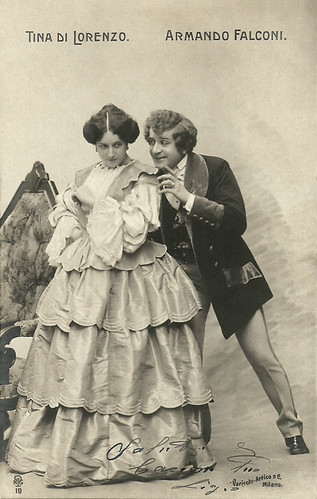
Italian postcard by NPC, no. 19. Photo: Varischi Artico & Co., Milano.
Though he was foremost a theatre actor and comedian, Armando Falconi (1871-1954) had a prolific career as comedian in Italian cinema of the 1930s and early 1940s. He was married to the famous stage actress Tina Di Lorenzo, with whom he also often acted together.

Italian postcard by Garzini e Pezzini, Milano, 1908.
Leopoldo Fregoli (1867-1936) was one of the first vaudeville actors who used film in his acts. Fregoli was famous for his rapid transformation acts, in which he did impersonations of famous artistic and political characters. In 1898 he bought a Cinematographe from the Lumière brothers and started to show shorts, named Fregoligraph, as part of his stage act. These were recordings of his transformation acts.

French postcard by Edition Pathé Frères. Photo: X.
One the most popular comedians in the French and the Italian silent cinema was André Deed (1879-1940) who was known under the names of Boireau and Cretinetti. In 1908, the Torinese company Itala lured him from Pathé to Italy, where Deed started the series of Cretinetti (‘little stupid’). He not only acted, but also directed his films. Deed behaved in a quite anarchic way, creating destruction and pursuits allover. Between 1909 and 1911 and between 1915 and 1920 Deed made 90 shorts with Cretinetti, such as the absurdist Cretinetti e le donne (1910), in which fanatic women tear the man to pieces. In the end all his loose limbs gather again.

French postcard. Photo: Pathé. Caption: M[ademoise]lle Frascaroli.
Valentina Frascaroli (1890-1955) was an Italian actress of the silent screen. After a training in dance and acting, she performed on stage. In 1909 she was hired by Itala Film, first as a screenwriter, then as actress. At Itala, she became the beloved companion of former Pathé comedian André Deed, known in Italy as Cretinetti and in France as Gribouille. She followed him to France when he returned to Pathé, now as Boireau. Frascaroli also had her own comedies there as the character Griboulette. Between 1915 and 1922 she acted in many, mostly dramatic Italian films such as Maciste alpino (1916), Tigre reale (1916), La guerra e il sogno di Momi (1917), etc. - mostly at Itala Film. Already in the early 1910s, she had acted opposite Ermete Zacconi in Padre (1912) and would be paired with him again in L'emigrante (1915). Frascaroli retired from the screen in 1925 but continued to perform on stage.

Italian postcard by IPA CT Duplex, no. 5899. Photo Comerio, Milano. V. Uff. Rev. St. Terni. Edoardo Ferravilla in Tecoppa & c.. Caption (in Milanese dialect): Gajna: I am a bit in shambles, so to say! My wife is at home with her children, which are a bit also mine! Ferravilla here performs his character Tecoppa.
Edoardo Ferravilla (1846-1915) was an actor and playwright of the Italian stage and silent screen. He performed in Milanese dialect and became the darling of the Italian public. Between 1913 and 1915, Ferravilla also had a short but successful film career. He thus immortalised some of his most popular sketches, and linked the early cinema to the repertoire of an ancient stage tradition.

Italian postcard by Magazine Film - corriere dei cinematografici, Napoli / Roma. Photo Roseo & Co, Naples / Caesar Film.
Italian screen and stage actor and director Camillo De Riso (1854-1924) was most famous for his comedies at the companies Ambrosio, Gloria and Caesar. In 1912 he was hired by Ambrosio Film in Turin, where he formed a successful trio with Gigetta Morano and Eleuterio Rodolfi, contributing with his rotund face, small size and generous look of bourgeois bonhomme. Examples are Un successo diplomatico and L’oca alla Colbert, both 1913 and both directed by Rodolfi. The films of the trio were often based on Italian and French fin de siecle pochades and grew in length over the years. In late 1913, De Riso started at the Gloria company. Here he created the gay epicure and shameless libertine character of ‘Camillo’, and directed himself in a series of comical shorts between 1913 and 1914.

Italian postcard by Tip. Sent by mail in 1922.

Italian postcard by La Rotofotografica / Unione Cinematografica Italiana, no. 137.
Italian comical actor Ferdinand Guillaume (1887-1977) was famous in the 1910s as Tontolini and as Polidor. He was enrolled by the Cines company in 1910 together with his brother Natale and their wives. Guillaume was launched as the character Tontolini, in 1912 also known in Britain and the US as Jenkins. Guillaume provided Cines and Italy an international reputation in the field of comedies. Actress Lea Giunchi, who was married to Natale (Natalino) Guillaume, often played as 'Lea' in the Tontolini comedies. Later she became the regular film partner of Kri-Kri (Raymond Frau), who more or less substituted Guillaume when the latter moved over to Pasquali. After some 100 shorts as Tontolini, and after the success of his first feature-length film, Pinocchio (Giulio Antamoro, 1911), Ferdinand Guillaume went over to the Pasquali company. Here he created the character of Polidor named after a horse in his old circus shows. From 1912 till 1914, he shot some 100 Polidor films, which were distributed all over Europe and the US.

Italian postcard by Fotocelere.
Italian actress Luigia 'Gigetta' Morano (1887–1986) was very popular as a comedian in the early 1910s at the Ambrosio film studio. She had her own comic series with the type Gigetta. Together with Eleuterio Rodolfi, her partner on screen and her most prolific director, she did countless comedies, both shorts and longer films. At Ambrosio, she also acted in dramatic parts, e.g. as Lucia in I promessi sposi (Eleuterio Rodolfi, 1913).

Italian postcard by Fotocelere.
Eleuterio Rodolfi (1876-1933) was an Italian actor, director and scriptwriter, who was highly active in the Italian silent cinema. For Ambrosio, Rodolfi acted in some 95 films of which some 80 ones were directed and scripted by himself. Many of these were comedies in which Rodolfi and Gigetta Morano played ‘Gigetta’ and ‘Rodolfi’. In contrast to the previous ‘comiche’ the anarchist farces by Cretinetti and others focused on speed and havoc, the comedies with Gigetta and Rodolfi were true ‘commedie’, so more situational, boulevardier, less speedy, and often hinting at forbidden fruits and voyeurism.

Italian postcard by Ed. Vettori, Bolgna. Angelo Musco in San Giovanni Decollato (Telemaco Ruggeri, 1917).

Italian postcard. This could be a postcard for either the film San Giovanni Decollato (Telemaco Ruggeri, 1917) or the play by Nino Martoglio on which it was based and which he had written for Musco. Angelo Musco (1872-1937) played in both film and stageplay. The woman on this card could be Rosina Anselmi, playing Musco's wife. All the actors in the play repeated their roles in Ruggeri's film, and Martoglio scripted the film too.

Italian postcard. Photo Scorrone.
Italian stage and film actor Oreste Bilancia (1881-1945) was highly active in Italian silent and sound cinema and also in the late silent cinema of the Weimar republic. He mostly worked as supporting actor, but occasionally he played the main character. The rotund Bilancia, often wearing a monocle, represented the bonvivant and gentleman in many Italian silent films. In the 1930s and early 1940s Bilancia acted in many Italian comedies, a.o. with Erminio Macario.

Italian postcard by G.B. Falci, Milano, no. 322. Photo: Leda Gys in the comedy Santarellina (Eugenio Perego, 1923).
Film diva Leda Gys (1892-1957) starred in ca. 60 dramas, comedies, thrillers and even Westerns of the Italian and Spanish silent cinema. Her claim to fame came with the film Christus (1916), shot in Egypt and Palestine, where Gys performed the Madonna.

Italian postcard by Ed. G.B. Falci, Milano. Pina Menichelli and Marcel Lévesque in La dame de Chez Maxim's (Amleto Palermi, 1923).
The comedy La dame de Chez Maxim's was one of diva Pina Menichelli's last films. With this film and with Occupati d'Amelia (Telemaco Ruggeri, 1925), both adaptations of popular Georges Feydeau boulevard comedies, Menichelli proved she was well able to do comedy and not only melodramatic and 'vampy' films. In both films one of her co-stars was the French Marcel Lévesque, on the far right on this card.

Italian postcard by NPC, no. 19. Photo: Varischi Artico & Co., Milano.
Though he was foremost a theatre actor and comedian, Armando Falconi (1871-1954) had a prolific career as comedian in Italian cinema of the 1930s and early 1940s. He was married to the famous stage actress Tina Di Lorenzo, with whom he also often acted together.
No comments:
Post a Comment